9 Proven Mobile App Monetization Strategies for 2025
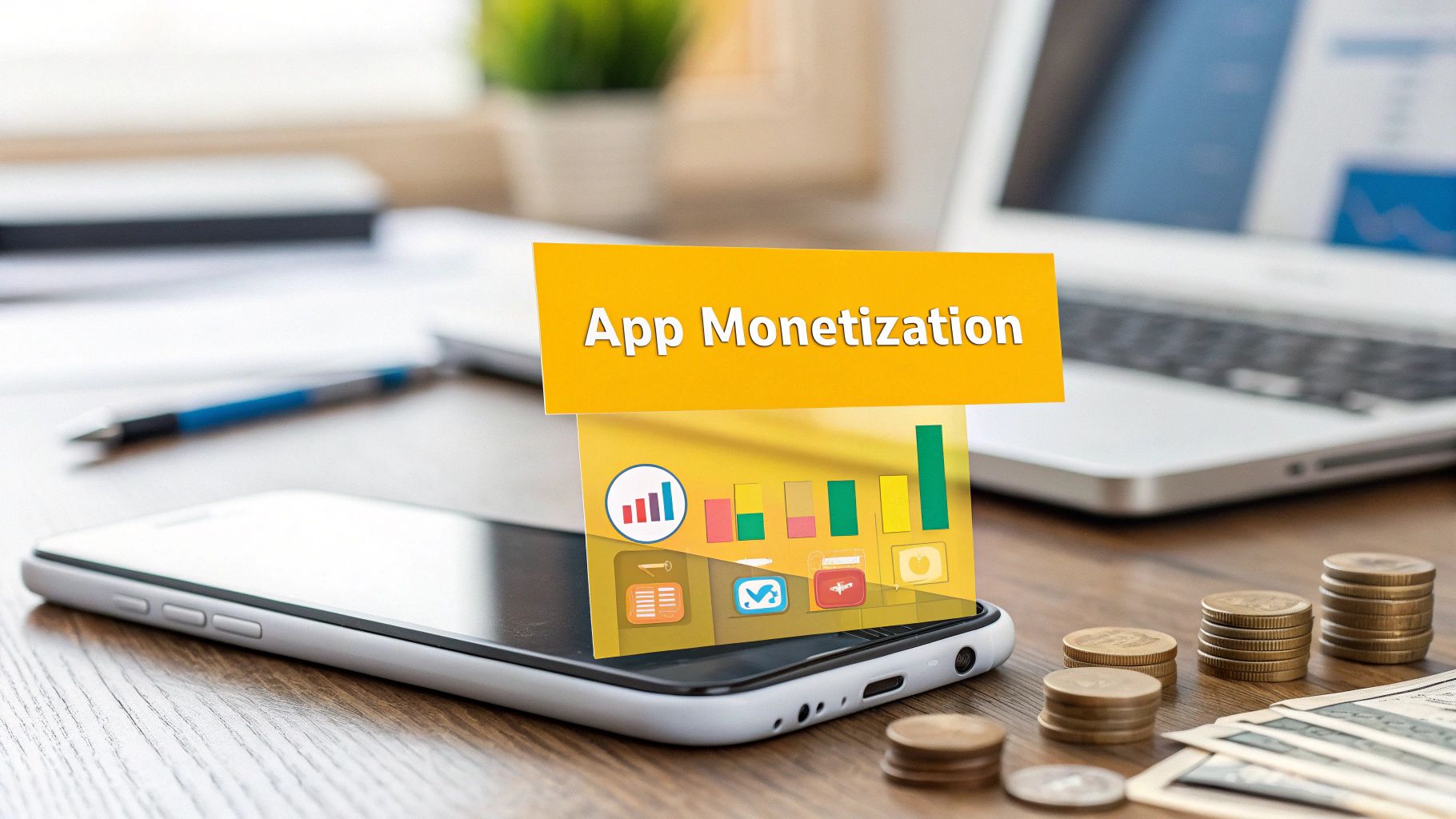
Building a great mobile app is only half the battle; unlocking its revenue potential is the other. The mobile landscape is fiercely competitive, and a one-size-fits-all approach to earning money simply doesn't work. The key to sustainable success lies in choosing the right mobile app monetization strategies that align with your app's purpose, your users' expectations, and your business goals. A poorly chosen model can alienate users and sink an otherwise brilliant application, while a well-executed strategy can transform it into a profitable powerhouse.
This guide moves beyond the basics to provide a comprehensive roundup of the most effective monetization models available. We will dissect nine proven strategies, exploring their mechanics, strengths, weaknesses, and real-world applications. For a comprehensive overview of various approaches, consider exploring these 9 Proven Monetization Strategies for Apps in 2025, which delves into models like freemium, subscriptions, and more.
Our focus is on actionable intelligence. We will cover everything from the classic Paid Download and In-App Purchase models to more nuanced approaches like Sponsorships and Hybrid Monetization. You will learn not just what these strategies are but how to implement them effectively. By the end, you'll have a clear roadmap to not only generate revenue but also enhance user experience and foster long-term growth. Whether you're a startup CTO, a product manager, or part of a marketing team aiming to improve digital outreach, these insights will help you build a robust and scalable financial foundation for your digital product. Let's explore the methods that can turn your app into a thriving business.
1. Freemium Model
The freemium model is a cornerstone among mobile app monetization strategies, blending "free" and "premium." It allows users to download and use an app with a core set of features at no cost. Revenue is generated by enticing a portion of this free user base to upgrade to a paid version, which unlocks advanced functionalities, removes restrictions, or offers an enhanced user experience.
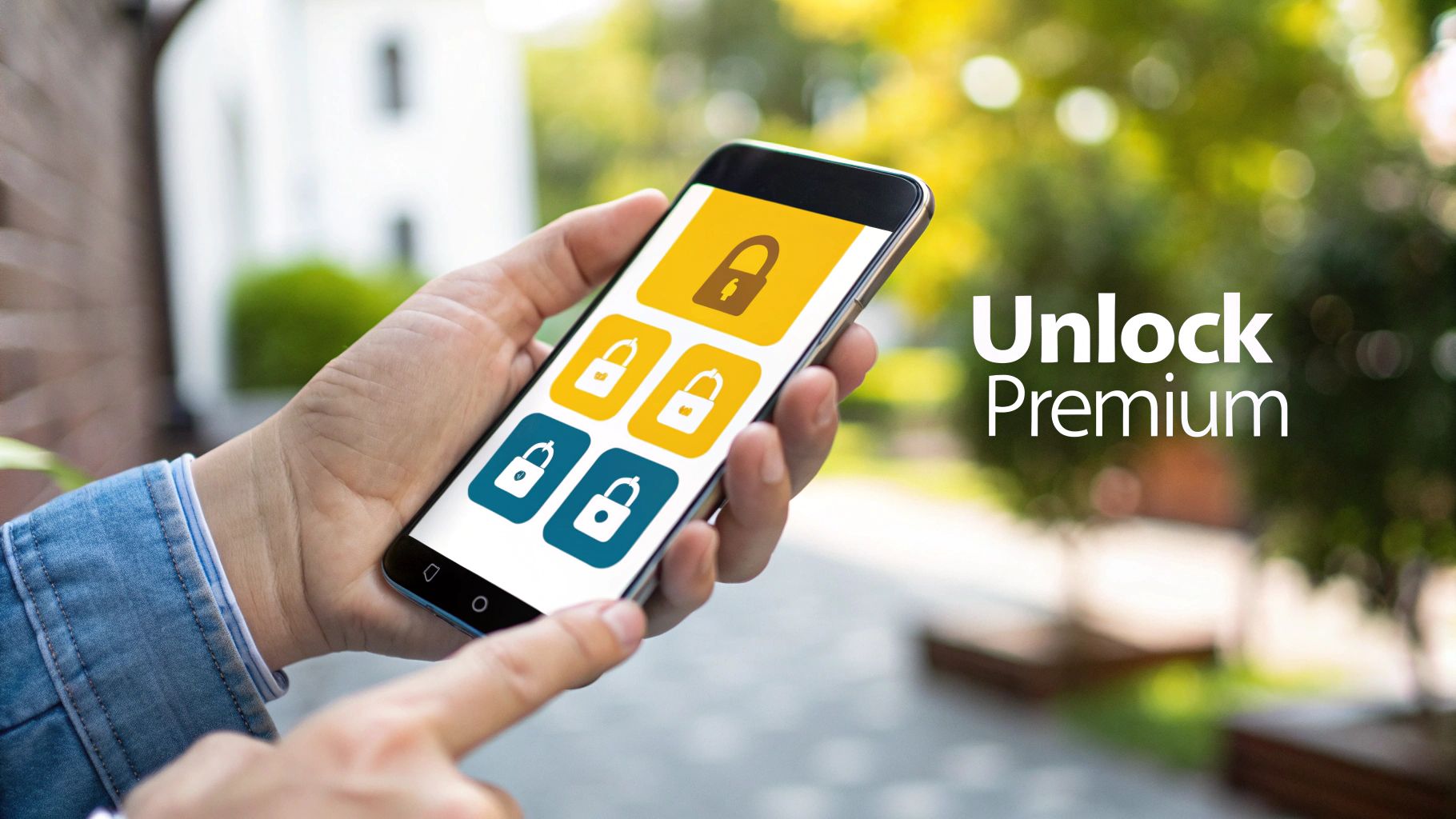
This approach is powerful because it removes the initial barrier to entry, enabling your app to build a large user base quickly. Once users are engaged and see the value in your app’s basic offerings, the appeal of premium features becomes a natural next step. The key is to make the free version valuable enough to retain users but limited enough to encourage conversions.
How to Implement the Freemium Model
Successfully implementing a freemium strategy requires a delicate balance between the free and paid tiers.
- Offer Substantial Free Value: The free version must be genuinely useful and solve a real problem for the user. A robust free offering builds trust and engagement, making users more receptive to upgrade prompts. Spotify, for example, offers a massive music library for free, creating a sticky experience that makes its premium ad-free and offline features highly desirable.
- Create Clear Upgrade Triggers: Don't hide your premium features. Instead, use strategic limitations that users will naturally encounter as their engagement deepens. Dropbox does this perfectly by limiting free storage space. As users store more files, the need for a paid plan becomes self-evident.
- Communicate the Value Proposition: Clearly articulate what users gain by upgrading. Use in-app messaging, paywall screens, and feature callouts to highlight the benefits of the premium version. LinkedIn Premium, for instance, explicitly details benefits like InMail credits and seeing who viewed your profile.
Key Insight: Your free tier is not just a demo; it's a powerful marketing and user acquisition tool. The goal is to convert users by demonstrating ongoing value, not by frustrating them with an overly restrictive experience.
2. In-App Purchases (IAP)
In-app purchases (IAP) are a dominant force among mobile app monetization strategies, allowing users to buy digital goods, services, and features directly from within a free-to-download app. This model is exceptionally popular in mobile gaming but has proven effective across a wide range of categories, from productivity tools to dating apps, by offering users a way to enhance their experience on their own terms.
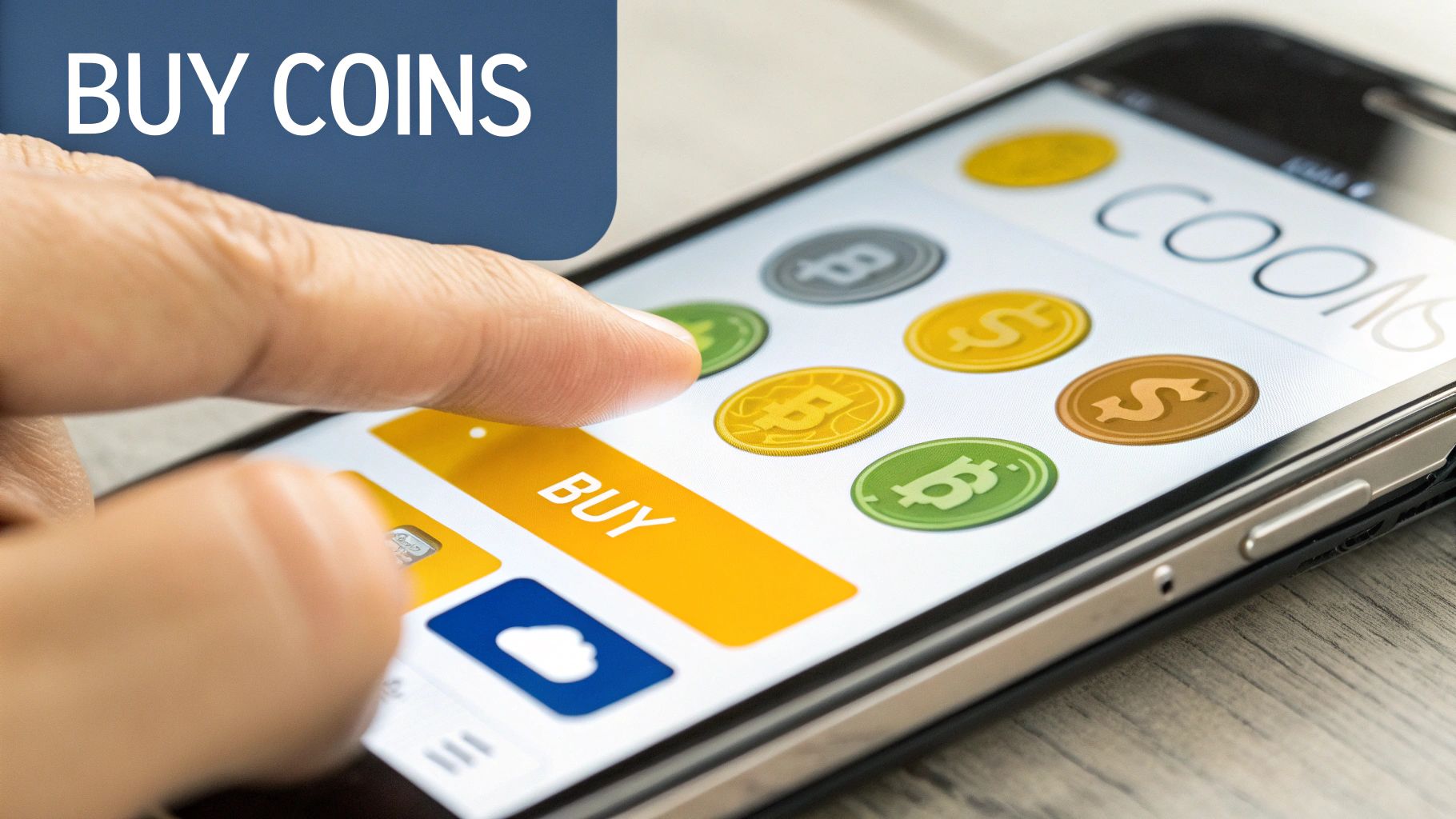
Unlike a freemium model's one-time upgrade, IAPs provide ongoing revenue opportunities through repeatable or one-off transactions. The strategy thrives on creating a compelling core loop that makes optional purchases feel like valuable enhancements rather than frustrating necessities. Success hinges on integrating purchases that feel natural and rewarding, encouraging users to spend willingly to accelerate progress, unlock content, or customize their experience.
How to Implement In-App Purchases
A successful IAP model requires a deep understanding of user motivation and careful economic design. It's about enhancing the experience, not exploiting the user.
- Offer Compelling Value: Purchases must provide a clear and immediate benefit. In Clash of Clans, buying gems directly speeds up construction and training, a tangible advantage that players can instantly recognize. Similarly, Tinder's Super Likes and Boosts give users a direct way to increase their visibility and matching potential.
- Segment Your Offerings: Cater to different user spending habits by providing a range of price points. A mix of low-cost consumables (like extra lives in Candy Crush Saga) and high-value permanent items (like unlocking a character) allows both casual spenders and dedicated "whales" to contribute to your revenue.
- Optimize Purchase Placement and Timing: Use data analytics to identify moments when users are most engaged or in need of a boost. Presenting an offer at the right time, such as after a near-win or when a user is close to a goal, significantly increases conversion rates. A seamless transaction flow is also critical; for more on this, you can explore insights on how to improve app performance on getnerdify.com.
Key Insight: The most effective IAPs feel like a natural extension of the user journey. They should empower users and deepen their engagement, making them feel smart for making a purchase rather than forced into one.
3. Subscription Model
The subscription model has emerged as a powerhouse among mobile app monetization strategies, shifting the focus from one-time purchases to building long-term, recurring revenue. In this model, users pay a regular fee, typically monthly or annually, for continuous access to your app's content, services, or premium features. This creates a predictable and stable income stream, which is highly valued by developers and investors alike.
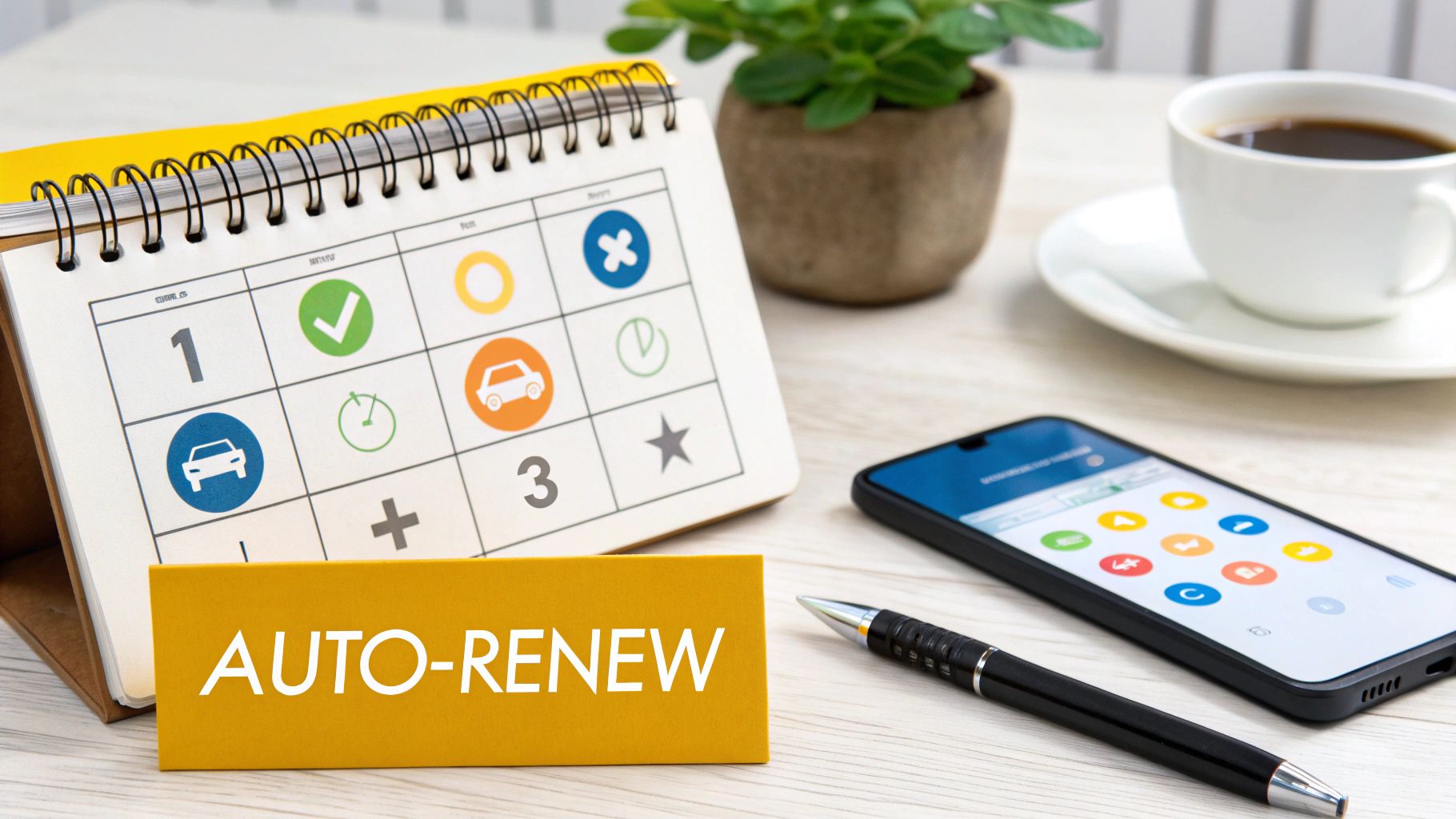
Unlike single-purchase models, subscriptions foster an ongoing relationship with the user. This dynamic incentivizes developers to consistently update and improve the app, ensuring it remains valuable enough to justify the recurring payments. The success of this model is evident in industry giants like Netflix and Spotify, who have built empires by providing ever-evolving libraries of content that keep subscribers engaged month after month.
How to Implement the Subscription Model
A successful subscription strategy hinges on delivering undeniable, continuous value that users are happy to pay for regularly.
- Offer Compelling Free Trials: A free trial is your best sales tool. It allows users to fully experience the benefits of your premium offering without commitment. Calm, the meditation app, offers a 7-day trial that immerses users in its premium content, making it much easier to convert them into paying subscribers once they’ve seen the value firsthand.
- Provide Tiered and Flexible Pricing: Not all users have the same needs or budget. Offering multiple subscription tiers (e.g., basic, premium, family) can broaden your appeal. Additionally, providing an annual plan at a discount encourages longer-term commitment and reduces churn. To maximize revenue, it's crucial to experiment with various subscription pricing strategies to find the sweet spot for your audience.
- Continuously Add Value: Subscribers expect their experience to improve over time. Regularly adding new features, fresh content, or exclusive updates is essential for retention. Duolingo Plus justifies its subscription not just by removing ads but by constantly adding new courses and learning tools, keeping the platform fresh and effective.
Key Insight: The subscription model transforms your app from a product into a service. Your primary goal is no longer just user acquisition but sustained user retention, which is achieved by consistently proving your app's worth.
4. In-App Advertising
In-app advertising is one of the most prevalent mobile app monetization strategies, allowing developers to earn revenue by displaying paid advertisements from third parties within their app. This model is particularly effective for apps with large, engaged user bases, as revenue is typically generated based on impressions (CPM), clicks (CPC), or actions taken by the user (CPA).
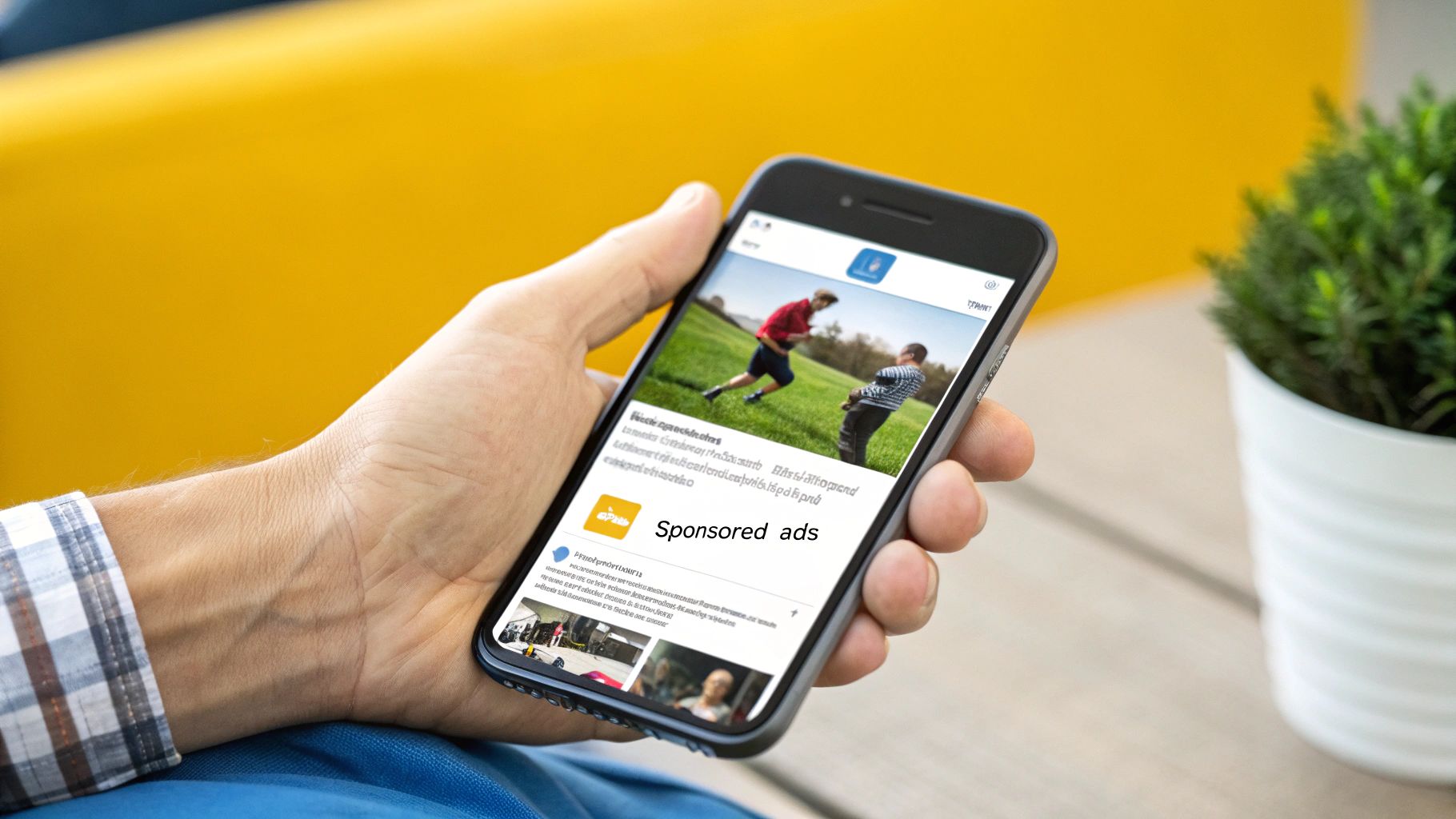
The primary advantage of this model is its ability to generate income without charging users directly, making the app completely free to download and use. Popular ad formats include unobtrusive banner ads, full-screen interstitial ads shown at natural transition points, rewarded video ads that offer users in-app currency for watching, and native ads that blend seamlessly with the app's content.
How to Implement In-App Advertising
Effective implementation hinges on integrating ads in a way that feels natural and non-disruptive to the core user experience.
- Balance Ad Frequency and User Experience: Bombarding users with ads is a surefire way to increase churn. The key is to find the right frequency and placement. Words with Friends, for instance, often displays ads after a turn is completed, a natural pause in the gameplay loop that minimizes disruption.
- Use Rewarded Ads for Positive Engagement: Rewarded video ads are a win-win. Users voluntarily watch a short video in exchange for a tangible benefit, like an extra life or in-game currency. This creates a positive association with ads rather than an intrusive one, making users more receptive.
- Leverage Ad Mediation Platforms: Don't rely on a single ad network. Ad mediation platforms like Google AdMob or Unity Ads allow you to access multiple ad sources, ensuring you get the highest possible bid for each ad impression and maximizing your fill rate and overall revenue. Combining this with a solid mobile app marketing strategy is essential for attracting the user volume needed for ads to be profitable.
Key Insight: The goal of in-app advertising is not just to display ads but to do so in a contextually relevant and user-friendly manner. When ads provide value or are presented at non-critical moments, they can become an accepted part of the app experience rather than an annoyance.
5. Paid Download Model
The paid download model, often called "pay-to-own," is the most traditional of all mobile app monetization strategies. It operates on a simple, direct transaction: users pay a one-time, upfront fee to download, install, and gain full access to your application from the app store. This approach provides immediate revenue for every download and is common for apps that deliver a complete, high-value experience right from the start.
This model's success hinges entirely on a powerful and clear value proposition. Since users cannot try the app before buying, they must be convinced of its quality and utility through its app store presence alone. It’s a high-stakes strategy that can lead to predictable revenue streams and a user base that is highly invested from day one.
How to Implement the Paid Download Model
Successfully launching a paid app requires building trust and demonstrating value before the user even clicks "buy."
- Invest Heavily in App Store Optimization (ASO): Your app store page is your primary sales pitch. Use compelling visuals, including high-quality screenshots and a professional preview video, to showcase the app’s functionality and user interface. Craft a descriptive title and a benefit-driven description to clearly communicate what problem your app solves.
- Leverage Social Proof with Reviews and Ratings: Positive reviews are the lifeblood of a paid app. Encourage early users to leave honest feedback. High ratings act as powerful social proof, assuring potential buyers that their investment is worthwhile. Apps like Procreate and Monument Valley thrive on their stellar reputations and glowing user testimonials.
- Offer Compelling Value: A paid app must provide a unique, feature-rich, or exceptionally polished experience that free alternatives cannot match. Forest, a productivity app, justifies its price by offering a creative, gamified solution to phone addiction, a value proposition that resonates strongly enough for users to pay upfront.
Key Insight: In a paid model, your marketing is your product's first impression. You are not selling an app; you are selling the promise of a solution, and every element of your app store listing must work to build the trust needed to close that sale.
6. Hybrid Monetization
The hybrid model is one of the most sophisticated and effective mobile app monetization strategies, involving the combination of two or more revenue models within a single app. Instead of relying solely on ads, subscriptions, or in-app purchases, this approach strategically blends them to cater to different user segments and maximize revenue potential. This allows developers to monetize non-paying users through ads while offering paying users premium, ad-free experiences or valuable in-app items.
This strategy acknowledges that a one-size-fits-all approach doesn't work for a diverse user base. Some users will never make a purchase but don't mind ads, while others will gladly pay to remove them or unlock content. A hybrid model allows you to capture value from both groups, creating a more resilient and lucrative revenue ecosystem. The key is to ensure the different models complement, rather than conflict with, each other.
How to Implement the Hybrid Monetization Model
Implementing a hybrid strategy requires a deep understanding of your user base and careful balancing of each revenue stream.
- Segment Your Users: Analyze user behavior to identify distinct groups. For example, segment users based on their engagement levels, spending habits, or tolerance for ads. This allows you to tailor specific monetization methods to each group. YouTube excels at this by serving ads to its massive free user base while offering YouTube Premium subscriptions to those who want an uninterrupted, feature-rich experience.
- Create Complementary Offers: Ensure your monetization methods work together harmoniously. A common approach is offering an ad-free experience as a paid upgrade. Clash Royale combines in-app purchases for immediate boosts with a subscription-like Battle Pass that provides long-term value, appealing to different spending preferences without creating conflict.
- A/B Test Your Combinations: Don't assume you know the perfect mix. Continuously test different combinations of monetization tactics on various user segments. You might test rewarded video ads versus a small one-time purchase to unlock a feature, or different subscription price points, to see what resonates best with your audience.
Key Insight: A successful hybrid model isn't about throwing every monetization method at the wall to see what sticks. It’s about creating a layered, intelligent system where each revenue stream is optimized for a specific user segment, enhancing the overall user experience rather than detracting from it.
7. Sponsorship and Partnership
Sponsorship and partnership models are advanced mobile app monetization strategies where you collaborate directly with other brands. Instead of relying on ad networks, you form direct deals with companies that want to reach your user base. This can manifest as sponsored content, integrated brand experiences, or exclusive rewards funded by a partner.
This strategy is highly effective for apps with a well-defined and engaged niche audience. A successful partnership feels less like an advertisement and more like a valuable feature, offering genuine utility to the user while providing the sponsor with targeted exposure. It moves beyond simple banner ads to create authentic, integrated marketing moments.
How to Implement Sponsorship and Partnership
Building successful partnerships requires a strategic approach that aligns your app, your users, and your partner’s goals.
- Ensure Brand and Audience Alignment: The most crucial element is relevance. A partnership will only succeed if the sponsor's brand, products, or services genuinely resonate with your users' interests and needs. For example, the navigation app Waze partners with brands like McDonald's and Dunkin' to display branded location pins along a user's route, offering a helpful and contextually relevant promotion.
- Develop a Professional Media Kit: To attract high-quality sponsors, you must present your app as a valuable marketing channel. Create a media kit that details your user demographics, engagement metrics (like daily active users and session length), and potential partnership opportunities. This professional approach demonstrates your value and streamlines negotiations.
- Maintain Editorial Control: Never sacrifice your user experience for a sponsorship deal. Clearly define the terms of the partnership to ensure you retain control over how sponsored content is presented. The content should feel native to your app and maintain the trust you've built with your audience. Strava, a fitness tracking app, implements this well by featuring sponsored challenges that encourage user activity, seamlessly blending brand promotion with its core purpose. A well-crafted sponsorship plan is a key part of any comprehensive digital marketing plan.
Key Insight: The best partnerships provide mutual value. Your users get relevant offers or enhanced features, your partner gets targeted brand exposure, and you generate revenue without disrupting the user experience.
8. Data Monetization
Data monetization is one of the more sophisticated mobile app monetization strategies, involving the practice of generating revenue from user data. This is not about selling individual personal information; instead, it focuses on collecting, aggregating, and anonymizing user data to derive valuable insights. These insights are then sold to third parties, such as market researchers, advertisers, or corporate strategists.
This strategy is particularly effective for apps with large, active user bases, where the collective data can reveal significant trends and patterns. For example, a fitness app might provide aggregated data on activity levels by region, or a navigation app like Google Maps can analyze traffic patterns to offer real-time updates. The core principle is to transform raw, anonymous user activity into commercially valuable intelligence while rigorously protecting user privacy.
How to Implement Data Monetization
Implementing a data monetization strategy requires a strong ethical framework and absolute transparency to maintain user trust.
- Prioritize Anonymity and Aggregation: Never sell personally identifiable information (PII). All data must be anonymized and aggregated to represent trends, not individuals. This is the cornerstone of ethical data monetization and is non-negotiable for compliance with regulations like GDPR and CCPA.
- Maintain Full Transparency: Your users must know how their data is being used. Provide a clear, easy-to-understand privacy policy that explicitly states you use aggregated, anonymous data for business purposes. Offering a clear opt-out mechanism is crucial for building and maintaining trust.
- Partner with Reputable Firms: Carefully vet any third party you plan to sell data insights to. Work with established market research firms, data analytics companies, or platforms that have a proven track record of ethical data handling. This protects both your users and your brand's reputation. For a deeper dive into the concept and legal aspects of leveraging information for revenue, consider exploring the broader topic of monetization of data.
Key Insight: Data monetization is not about selling users' secrets. It's about translating collective, anonymous behavior into actionable market intelligence. Success hinges on your ability to uphold user privacy and communicate your practices with absolute clarity.
9. E-commerce Integration
E-commerce integration is one of the most direct mobile app monetization strategies, transforming your app into a digital storefront. This model involves embedding shopping functionality directly into the user experience, allowing them to browse and purchase physical products, services, or digital goods without ever leaving the app. It's a powerful way to capitalize on user engagement by bridging the gap between content consumption and commerce.
This approach is highly effective for apps where purchasing is a natural extension of the core user journey, such as in social media, lifestyle, or content-driven platforms. By making shopping a seamless part of the experience, you can tap into impulse buying behaviors and leverage your app's existing trust and engagement to drive sales. It essentially adds a transactional layer on top of your app's primary function.
How to Implement E-commerce Integration
Successful implementation hinges on making the shopping experience feel native and effortless, rather than a bolted-on feature.
- Ensure Seamless Integration: The shopping functionality should feel like an organic part of your app. For example, Instagram integrated shopping by allowing users to tap on products within photos and stories, leading them directly to a product page. This preserves the visual, discovery-based nature of the platform.
- Optimize the Mobile Checkout Process: A complicated checkout is the primary reason for cart abandonment. Streamline the process with minimal steps, support for mobile wallets like Apple Pay and Google Pay, and save user information for future purchases. The goal is to make buying as easy as a few taps.
- Implement Robust Search and Recommendations: Help users find what they want. A powerful search function combined with a personalized recommendation engine, like the one used by Pinterest, can significantly increase conversion rates. It guides users from visual discovery to a relevant purchase.
Key Insight: E-commerce integration succeeds when the transaction feels like a natural conclusion to the user's in-app activity. The focus should be on enhancing the user journey with purchasing opportunities, not disrupting it.
Mobile App Monetization Strategies Comparison
| Monetization Model | Implementation Complexity 🔄 | Resource Requirements ⚡ | Expected Outcomes 📊 | Ideal Use Cases 💡 | Key Advantages ⭐ |
|---|---|---|---|---|---|
| Freemium Model | Moderate: Requires feature gating and segmentation | Medium: Development of free & premium tiers | Moderate revenue with low conversion rates (1-5%) | Apps needing wide user base + premium upgrades | Low entry barrier; scalable; demos value pre-purchase |
| In-App Purchases (IAP) | High: Complex testing and balance needed | High: Pricing, analytics, and purchase flows | High revenue per user; continuous revenue stream | Games, content expansion, lifestyle apps | Flexible pricing; targets various spender types |
| Subscription Model | Moderate-High: Recurring billing and retention | Medium-High: Billing, trials, content updates | Predictable, recurring revenue; higher LTV | Services, streaming, ongoing content apps | Reliable cash flow; encourages long-term use |
| In-App Advertising | Low-Moderate: Integrate ad networks | Low-Medium: Ad mediation and targeting tools | Variable revenue; depends on user engagement | Free apps with large user base | No cost to users; passive income; multiple ad formats |
| Paid Download Model | Low: Simple purchase flow | Low: One-time payment setup | Immediate revenue; limited ongoing income | Premium quality apps; niche markets | Immediate revenue; high perceived value |
| Hybrid Monetization | High: Combining multiple models adds complexity | High: Analytics and optimization across methods | Increased ARPU by 20-40% over single models | Apps targeting diverse user groups | Maximizes revenue; reduces dependency on one model |
| Sponsorship & Partnership | Moderate-High: Partnership management | Medium-High: Sales and brand alignment | High revenue per deal; long-term collaborations | Apps with strong brand/user alignment | High revenue; enhanced credibility; user-friendly |
| Data Monetization | High: Data aggregation, privacy compliance | High: Infrastructure for analytics & compliance | Passive revenue; valuable market insights | Apps with large user data sets | High margins; complements other models |
| E-commerce Integration | High: Complex logistics, payments, inventory | High: Payment gateway, catalog, fulfillment | Potentially high transaction values and revenue | Lifestyle, fashion, food delivery, marketplace | Comprehensive ecosystem; multiple revenue points |
Choosing Your Path: How to Build a Winning Monetization Blueprint
The journey through the diverse landscape of mobile app monetization strategies reveals a fundamental truth: there is no single "best" model. As we have explored, from the accessible gateway of the Freemium model to the direct revenue of Paid Downloads, and the powerful blend of Hybrid approaches, each strategy offers a unique toolkit. The optimal path to profitability isn't about picking one item from a list; it's about engineering a custom blueprint that aligns perfectly with your app's purpose, your target audience's behavior, and your long-term business goals.
The most successful product managers, CTOs, and startup founders understand that monetization is not a feature tacked on before launch. It is a core component of the user experience, intricately woven into the app's design and value proposition. A poorly implemented strategy can feel intrusive and alienate users, while a well-designed one can actually enhance engagement and perceived value. The key is to shift your perspective from "How can we charge our users?" to "How can we deliver value that users are happy to pay for?"
Synthesizing Your Strategy: From Theory to Action
Building your winning blueprint requires a methodical, data-driven approach. Avoid the temptation to simply copy a competitor's model. Instead, use the insights from this article as building blocks for your unique structure. Here are the actionable next steps to translate these concepts into a concrete plan:
Deep User Persona Analysis: Go beyond basic demographics. What are your users' spending habits? Are they gamers accustomed to microtransactions (IAPs), professionals who value productivity tools (Subscriptions), or casual users who will tolerate ads for free content (In-App Advertising)? Your strategy must resonate with their expectations.
Value Proposition Mapping: Chart your app's core features against the different monetization models. Which features provide enough ongoing value to justify a subscription? Which could be offered as premium, one-time purchases? This exercise clarifies where and how you can naturally introduce monetization without disrupting the user journey.
Competitive Landscape Audit: Analyze not just direct competitors but also successful apps in adjacent categories. Document their pricing, what they offer for free, and how they integrate ads or partnerships. Look for gaps and opportunities where you can innovate and offer a more compelling value exchange.
The Power of Iteration and Partnership
Once you launch your initial strategy, the real work begins. The most crucial takeaway is that your initial mobile app monetization strategy is a hypothesis, not a final decree.
Key Insight: Your first monetization model is your best-educated guess. Sustainable revenue comes from continuous testing, listening to user feedback, and having the courage to pivot based on data.
This is where A/B testing becomes your most powerful tool. Test everything: the price points of your subscriptions, the placement and frequency of ads, the copy on your paywall screens, and the features included in your premium tier. Small adjustments, validated by data, can lead to significant increases in revenue over time.
For startups, SMEs, and even large enterprises, navigating this complex, iterative process can be daunting. The technical implementation of IAPs, subscription logic, and ad SDKs requires specialized expertise. This is where a strategic development partner becomes an invaluable asset. Aligning with a team that has a proven track record in building high-performance, revenue-generating applications can accelerate your path to profitability and help you avoid common pitfalls. An expert partner provides not just the code, but the strategic guidance needed to build a monetization engine that is both robust and seamlessly integrated into a superior user experience.
Ultimately, your mobile app is more than just a piece of software; it's a business. By thoughtfully selecting, combining, and continuously refining your mobile app monetization strategies, you transform a great idea into a sustainable, scalable, and successful enterprise. The path is challenging, but with a clear blueprint and a commitment to user value, your app can achieve a powerful and profitable place in the market.